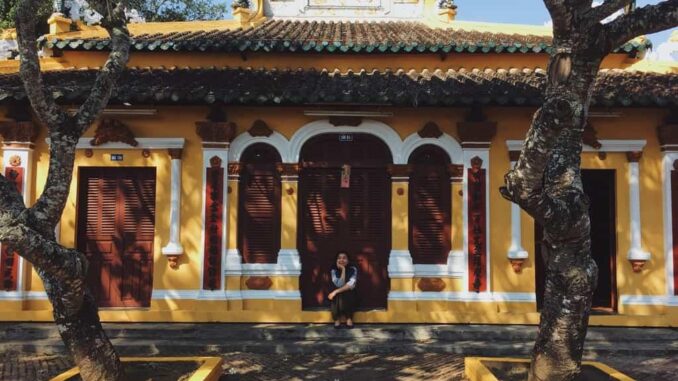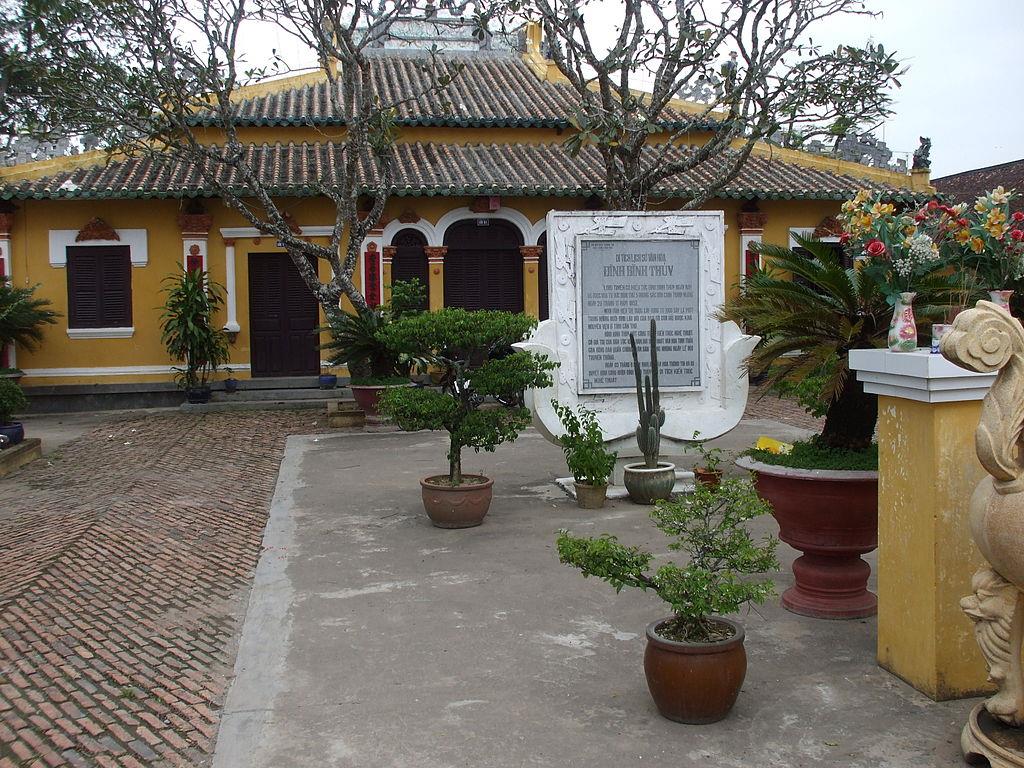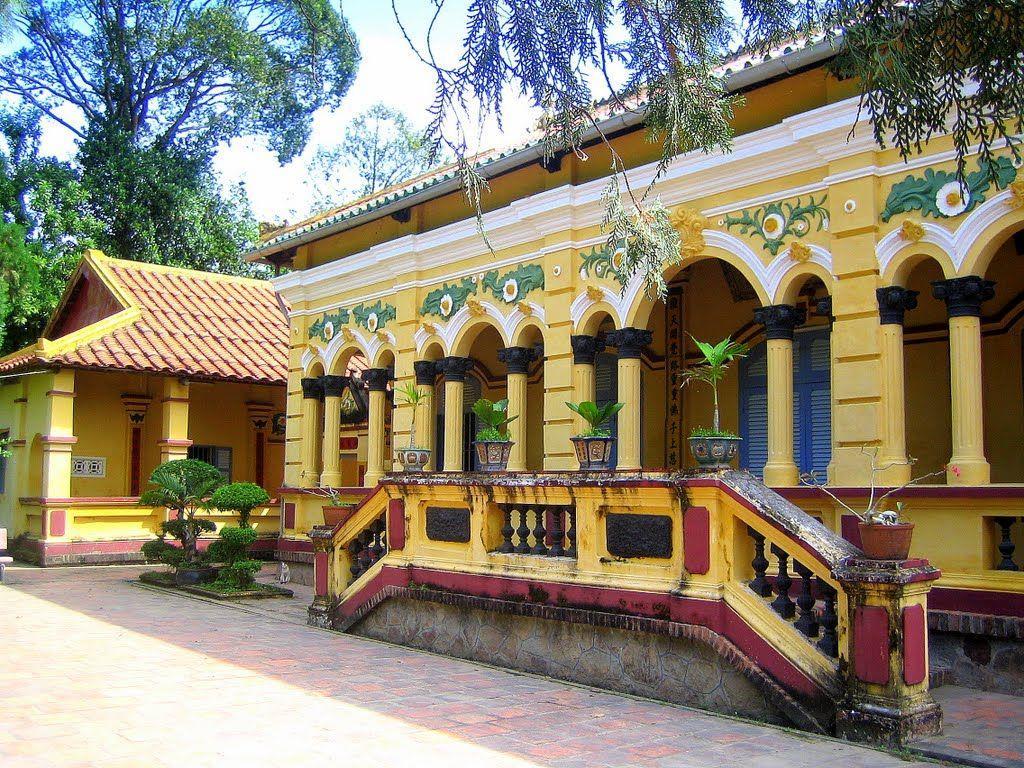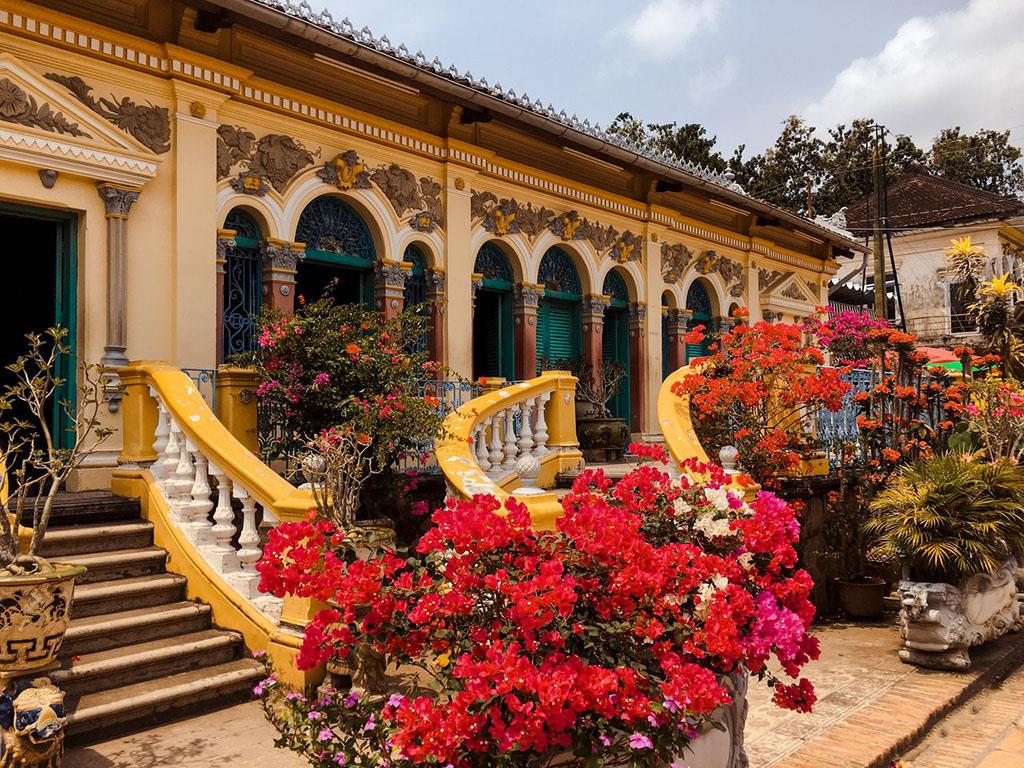
In the past, Long Tuyen was the name of a commune, but over time it has become a famous place covering a large area associated with the development history of Can Tho. This place has the meaning of ‘dragon stream’ or the ancient people called ‘dragon veins’, according to the image of Long Tuyen head like a dragon’s mouth and Long Tuyen canal like a winding dragon body.
Long Tuyen place includes from An Thoi market to the east of Tra Noc bridge and runs deep inside along the axis of Bui Huu Nghia – Binh Thuy, connecting with provincial road 923 and reaching to Long Tuyen ward. Due to its large scope and many ancient cultural and historical relics, this area is also known as Long Tuyen ancient village, with the focal point being Long Tuyen ancient temple – now known as Binh Thuy communal house.
Dinh Binh Thuy
 Dinh Binh Thuy is a work bearing the value of traditional art architecture of Vietnamese people during the reclaimed years in the southwestern region, with decorative motifs, delicate and vivid wood carving. Outside, there are two large shrines worshiping the god Nong and the Tiger god. Near the gate, there are two temples worshiping the god of the forest and the god Khai canal. The campus of Binh Thuy communal house is divided into 2 areas: the main communal area and the hamlet area. The main communal house has 5 houses including: 2 square houses which are the forecourt and the main hall, and 3 houses connecting the two square houses together. The hamlet includes: 1 theater and the house used to prepare offerings.
Dinh Binh Thuy is a work bearing the value of traditional art architecture of Vietnamese people during the reclaimed years in the southwestern region, with decorative motifs, delicate and vivid wood carving. Outside, there are two large shrines worshiping the god Nong and the Tiger god. Near the gate, there are two temples worshiping the god of the forest and the god Khai canal. The campus of Binh Thuy communal house is divided into 2 areas: the main communal area and the hamlet area. The main communal house has 5 houses including: 2 square houses which are the forecourt and the main hall, and 3 houses connecting the two square houses together. The hamlet includes: 1 theater and the house used to prepare offerings.
The vestibule and main hall are square, each side has 6 columns. The main hall has 3 overlapping roofs in the architectural style “upper floor, lower porch”; On the roof, there are statues of humans, unicorns, and carp with the dragon; columns are carved with dragons, peony flowers wrapped around; inside, there are committees to worship the village citadel and worship the people with meritorious services to the country such as: Vo Huy Tap, Dinh Cong Trang, Nguyen Trung Truc, Bui Huu Nghia …
Despite the ups and downs of history, Binh Thuy communal house still retaining many unique architectural artistic elements of an ancient village in the southwestern river region. Until today, Binh Thuy communal house continues to be preserved, becoming a valuable tourist attraction of Can Tho. Every year, this place usually takes place on Thuong Dien (April 12/14 lunar calendar), Summer Festival (December 14/15) is very crowded, bustling with performances and folk games such as: singing baa, releasing ducks, tug of war, female main work … maintained from the past to the present day, attracting a large number of people to participate.
Nam Nha Pagoda
 Nam Nha pagoda not only impresses pilgrims by the beautiful pure natural landscape – superficial ancient architecture, hidden in the old green garden carefully cared for, but a long history attached The attachment to the anti- French revolutionary movement is also the reason why any tourist coming to Can Tho wants to visit.
Nam Nha pagoda not only impresses pilgrims by the beautiful pure natural landscape – superficial ancient architecture, hidden in the old green garden carefully cared for, but a long history attached The attachment to the anti- French revolutionary movement is also the reason why any tourist coming to Can Tho wants to visit.
The forerunner here was a traditional medicine store named Nam Nha Duong, later rebuilt and renamed Nam Nha Pagoda, both a place of worship and the headquarters of the Dong Du movement (1907-1940. ). During the resistance war against the French, the famous pagoda was the place to gather and nurture the patriotic movement and produce patriotic and indomitable masters of patriotism and indomitable spirit against foreign invaders. Over time, the pagoda today has not looked as magnificent as before, but is one of the few ancient architectural works with slightly intact value.
The pagoda consists of three main zones: the Chinh Dien house, the Lan house and the Tay Lan house. The Main Palace is the place where the shrine is located, consisting of three bronze Buddha statues, besides the temple also preserves relatively spacious rare antiques, especially wooden tables and chairs in the temple with carved lines. The delicate and bold illustration of the old Southern region. In front of the temple gate, 3 words “Nam Nha Duong” and 2 opposite sentences on both sides of the gate seem to be in shadow on the bank of Binh Thuy River, increasing the village’s serenity and tranquility.
Unlike the temples in our country, the monks at Nam Nha pagoda are vegetarian, do not shave their heads, do not wear brown, use the cultivation of virtuous virtue as a guide, so the atmosphere in the temple is always simple and close. close.
Binh Thuy ancient house
 Besides Nam Nha Duong and Binh Thuy communal house, this area also has many old houses. But the most prominent in the ancient village of Long Tuyen is the Long Tuyen ancient house of the Duong family built in 1870 – often called “the old house of Binh Thuy”.
Besides Nam Nha Duong and Binh Thuy communal house, this area also has many old houses. But the most prominent in the ancient village of Long Tuyen is the Long Tuyen ancient house of the Duong family built in 1870 – often called “the old house of Binh Thuy”.
Binh Thuy Ancient House is a rare remaining ancient house model that helps researchers and archaeologists learn about the daily life, culture as well as the development of culture under existence through 2 period. The house is a harmonious combination between Eastern and Western cultures, giving this place a modern beauty, but still bold Vietnamese national culture.
The house has a French house architectureThe floor is 1m higher than the ground, there are four steps forming a bow connecting the house with a large yard, high ceilings, beautifully decorated patterns, opening many large and small doors with quite simple iron frames to help the house. airy, the facade decorated with embossed relief is shown many beautiful patterns. Leading up to the main house are two prominent yellow curved staircases.
Step through the solid gate fence made of concrete and iron in the style of a French mansion is an auxiliary gate lying in line with the fence gate, sloping to the left from the road, built according to Asian architecture. The system of rafters, sesame, crossbeams are made of wood, roofing with tiled pipes, roof edges made of green enamel. On the roof, gable heads are decorated with flowers, goldfish, unicorns, buffalo riders, flower pots … with extremely delicate cement.
Not only famous for its splendid and magnificent main house, Binh Thuy ancient house is also famous near and far from Binh Thuy orchid garden and a rich and valuable antiques storehouse. It is known that Mr. Duong Van Ngon, a fifth-generation descendant of the Duong family, has a hobby of playing ornamental flowers. Mr. Ngon has collected many rare orchid varieties from all over the home garden. In particular, there is a very famous Mexican Kim cactus over 40 years old.
Many films such as L’amant, The Beauty of Tay Do, The White Flower River … have been filmed at this famous house.
Viettravel
